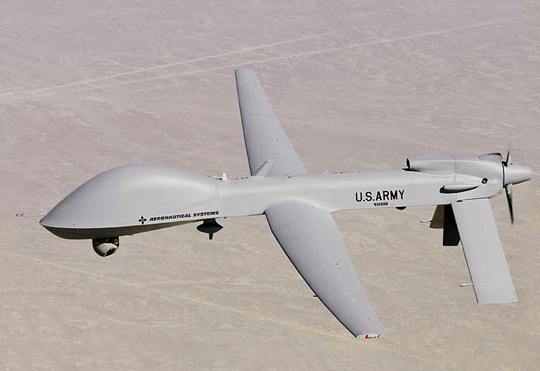

The MQ-1C Gray Eagle (previously the Warrior and also called Sky Warrior and ERMP (Extended-Range Multi-Purpose) is a Medium Altitude Long Endurance (MALE) unmanned aircraft system (UAS) under development byGeneral Atomics Aeronautical Systems (GA-ASI), funded by United States Army. It is an upgrade of the MQ-1 Predator.
The U.S. Army initiated the Extended-Range Multi-Purpose UAV competition in 2002, with the winning aircraft due to replace the RQ-5 Hunter. Two aircraft were entered, the IAI/Northrop Grumman Hunter II, and the Warrior. In August 2005, the Army announced the Warrior to be the winner and awarded a $214 million contract for system development and demonstration. The Army intends to procure eleven Warrior systems, each of these units has twelve UAVs and five ground control stations. With an expected total program cost of $1 billion, the aircraft became operational in 2009.
The Army sought to have the Warrior designated MQ-12, but the United States Department of Defense allocated the designation MQ-1C instead. It is planned to be operated by Task Force ODIN in Iraq and/or Afghanistan. In August 2010, the US Army announced that the MQ-1C had officially been assigned the name Gray Eagle.
The Army announced on 3 September 2010 that the integration of the AGM-114 Hellfire missile on the UAV had been so successful that 4 weaponized MQ-1Cs would be deployed to Afghanistan in late 2010.
Design
A Medium-Altitude Long-Endurance (MALE) UAV, the Gray Eagle has an increased wingspan and is powered by a Thielert Centurion 1.7 Heavy Fuel Engine (HFE).[9] This is a Diesel piston engine that burns jet fuel, giving the aircraft better performance at high altitudes. It will be capable of operating for 36 hours at altitudes up to 25,000 feet (7,600 m),[4] with an operating range of 200 nautical miles (400 km).
The aircraft's nose fairing has been enlarged to house a Synthetic Aperture Radar/Ground Moving Target Indicator (SAR-GMTI) system, and targeting is also provided with an AN/AAS-52 Multi-spectral Targeting System (MTS) under the nose. The aircraft can carry a payload of 800 pounds (360 kg) and may be armed with weapons such as AGM-114 Hellfire missiles and GBU-44/B Viper Strike guided bombs.
In May 2013, Raytheon delivered two electronic attack payloads as part of the Army's Networked Electronic Warfare, Remotely Operated (NERO) system. NERO gives the MQ-1C the ability to jam enemy communications. Also mounted on the C-12 Huron, mounting on the unmanned Grey Eagle gives reduced risk, reduced operating costs, and two to three times the endurance of electronic attack missions.
On 27 July 2013, General Atomics announced the successful first flight of the Improved Gray Eagle (IGE). The IGE is designed for increased endurance, with 23 additional hours compared to its Block I predecessor. It has 50 percent greater fuel capacity through its deep belly fuselage and features 50 percent or more payload capacity. The upgraded centerline hardpoint supports integration of a 500 pound optional external fuel tank or 360 degree sensor payload. The IGE's additional space, plus an improved Lycoming DEL-120 Heavy Fuel Engine (HFE), provides growth capability for an improved airworthiness design, with the potential of incorporating lightning protection, damage tolerance, and Traffic Collision Avoidance System (TCAS) features.
Reliability problems
Beginning in March 2011, Gray Eagles started showing poor reliability across all major subsystems. During that month, one Gray Eagle crashed in California when a faulty chip blocked a subsystem from sending commands to part of the aircraft's flight control surfaces. Flight testing was delayed, and was resumed when the chip was replaced, but it still left the drone with fewer available flight hours. The average time between failures of the aircraft or components is 25 hours, while the minimum required is 100 hours. The ground control station's time between failures is 27 hours, while the minimum time required is 150 hours. Sensors fail at 134 hours, compared to 250 hours required. In October 2011, a report concluded the Gray Eagle was meeting only four out of seven "key performance parameters," and its reliability continued to fall short of predicted growth. Software fixes have led to 11 unplanned software revisions, but has generally improved reliability.
Operational history
The Army's 1st Infantry Division's combat aviation brigade deployed to Iraq with developmental Grey Eagles in June 2010.
On 2 June 2012, the Gray Eagle reached a record 10,000 successful automatic launch and recoveries with the Automatic Takeoff and Landing System (ATLS). The system also landed with a 26 knot crosswind. By July 25, 2012, the Army’s Gray Eagle Block 1 aircraft has accumulated more than 35,000 flight hours since it was first deployed in 2008. On June 25, 2012, the Gray Eagle was deployed in its first full company of 12 aircraft.[16] Initial Operational Test and Evaluation (OT&E) was completed in August 2012.There are currently 50 aircraft in service with a greater than 80% system operational availability rate.
Full-rate production was planned for April 2013, with follow-on operational testing in 2015 using a new ground station in common with the RQ-7 Shadow.From 2008 to July 2013, the Grey Eagle has accumulated over 70,000 flight hours.



















